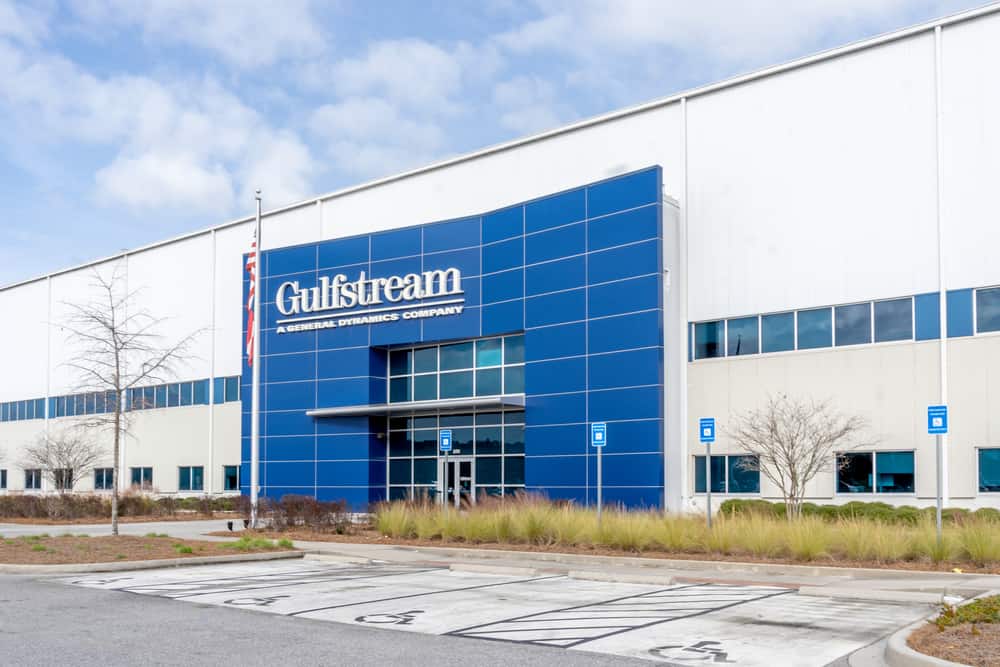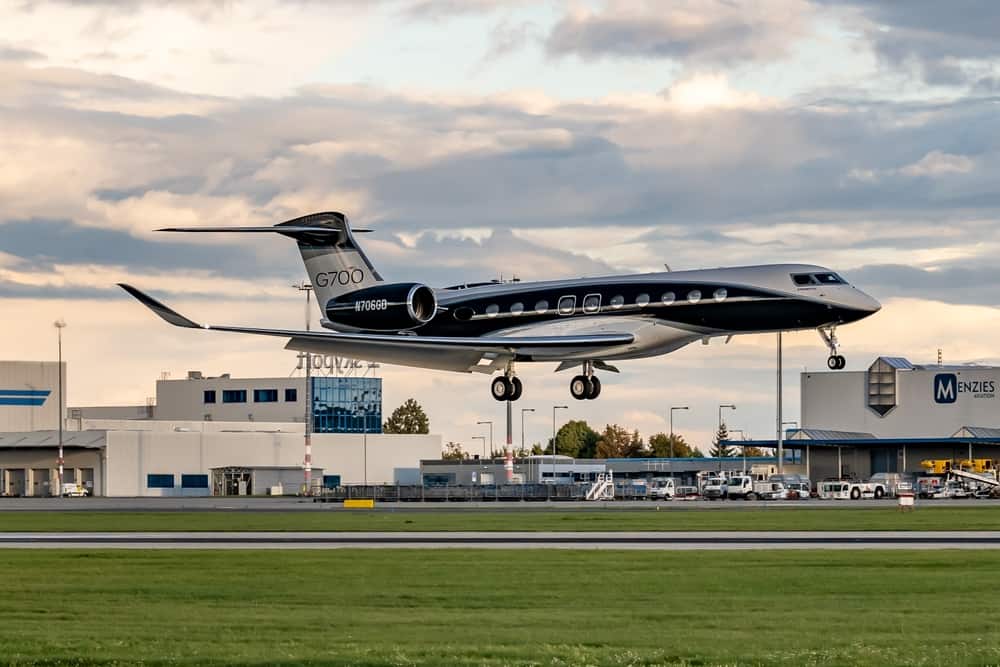Gulfstream Aerospace is a fully-owned subsidiary of General Dynamics. This American aircraft manufacturer designs, develops, markets, and maintains business jets and other aircraft, having manufactured more than 2,000 different types of aircraft since their inception in 1958.
Gulfstream Aerospace’s headquarters can be found in Savannah, Georgia, with Mark Burns serving as the company president.
Nevertheless, they do business on a global scale and have locations in different sites:
- Savannah and Brunswick, Georgia;
- Dallas, Texas;
- Appleton, Wisconsin;
- Lincoln, California;
- Las Vegas, Nevada;
- Long Beach, California;
- London, England;
- Mexicali, Mexico;
- West Palm Beach, Florida;
- and Westfield, Massachusetts.
Topics
Company History
In the 50s, Grumman Aircraft Engineering laid the groundwork for what would later become the successful aviation business Gulfstream Aerospace. This military aircraft manufacturer created a turboprop commercial jet called the Grumman Gulfstream, with a flight range of more than 2,000 nautical miles and space for 12 passengers. 200 Grumman Gulfstream (also known as Gulfstream I) planes were manufactured from 1959 to 1969, and some aircraft are still in use.
Following this turboprop’s incredible performance, in 1966, the firm designed the Grumman Gulfstream II, which was operated by jet engines and could cross the Atlantic with 16 passengers without stopping for fuel. To maximize productivity when this project was initiated, the civilian and military manufacturing activities were first kept separate. As a direct consequence, the manufacturing of civilian aircraft was transferred to Savannah in the state of Georgia.
At the beginning of 1973, American Aviation Corporation and Grumman Aircraft Engineering merged into one company. As a result of the sale of the Savannah factory and the Gulfstream line to American Jet Industries in 1987, Allen Paulsen was promoted to the role of chief executive officer and president of the firm. After that, he changed the corporation’s name to Gulfstream American and put the production of Gulfstream III at the top of his list of priorities.
Across the 80s and 90s, Gulfstream built planes with enhanced efficiency and regularly introduced new models. At the tail end of the 90s, General Dynamics completed its acquisition of Gulfstream, forming General Dynamics Aviation Services. By combining four new hangars and an existing facility in Massachusetts, General Dynamics Aviation Services became responsible for maintaining and refurbishing Gulfstream aircraft.
2001 saw the acquisition of Galaxy Aerospace by Gulfstream, which led to the rebranding of Galaxy’s midsize aircraft as the G100 and G200. These aircraft received upgrades from Gulfstream to have a longer flight range and more spacious interior. Through the acquisition of Galaxy Aerospace, Gulfstream was able to expand its fleet to include super-midsize jets.
In 2006, Gulfstream Aerospace established a Research and Development Center in Savannah, Georgia, as part of an expansion of the company’s headquarters. The undertaking was a portion of an overall growth strategy. Professionals from the fields of engineering, production, management, customer service, and materials are all part of the RDC.
Gulfstream Aerospace’s aircraft are manufactured and assembled in various locations:
- The completion of Gulfstreams’ midsize aircraft is in Dallas, Texas.
- Gulfstream Aerospace’s production facility for its heavy and ultra-large aircraft is located in Georgia, Savannah.
- A manufacturing plant in Mexicali, Mexico, is responsible for producing the parts, components, and wire cables.
- Furnishing the cabins, painting the outside of the planes, and installing the gear is done in several different finishing facilities in Wisconsin, Georgia, California, and Texas.
Gulfstream Services

The aerospace division of General Dynamics is renowned for its position as the industry’s preeminent manufacturer of business jets and the gold standard in plane repair, maintenance, and finishing solutions. It excels in the design process, craftsmanship, speed, stability, and dependability; uses technologically sophisticated control platform and interior technologies; and offers reliable service and support.
When using maintenance services from the original manufacturer, clients can reduce the amount of time their aircraft is grounded and get it airborne more quickly. Moreover, professionals from Gulfstream’s repair facility are available to assist customers in any part of the world with the best repair and maintenance services.
Here’s a full list of the services Gulfstream offers.
- Scheduled maintenance, parts, and labor
- Flight operations support
- Hangaring
- Flight crew staffing
- Technical information
- Systems coverage
- Insurance
The Gulfstream Field and Airborne Support Teams (FAST) are responsible for providing a prompt and well-coordinated solution to any aircraft on the ground (AOG) in case of an emergency. Hundreds of experienced professionals are posted in various locations throughout the globe.
Gulfstream professionals can promptly fix a problem with one of Gulfstream Aerospace’s planes at one of the 11 service facilities spread across four continents. In addition, support teams are designed to operate in the field or while flying if an aircraft is not located near a service department.
Products and Aircraft Types
After more than fifty years of production, the Gulfstream aircraft family represents a significant evolution and expansion of the line’s capabilities. Beginning in 2002, Gulfstream switched the signature Roman numbers they used to name the fleet to Arabic numerals.
Each aircraft has a price tag that varies anywhere from $10 million to $50 million.
Gulfstream aircraft models:
- Gulfstream G150
- Gulfstream G200
- Gulfstream G280
- Gulfstream G350
- Gulfstream G450
- Gulfstream G500
- Gulfstream G550
- Gulfstream G600
- Gulfstream G650
- Gulfstream G650ER
- Gulfstream G700
- Gulfstream III
- Gulfstream IV
- Gulfstream V
Most Famous Aircraft by the Company
Gulfstream G500
In 2003, Gulfstream G550 received the highly regarded Robert J. Collier trophy for its accomplishment in the design process while combining safety improvements and advances in aerospace engineering. This trophy is the most prestigious award in the field of the aerospace industry in North America. The same was awarded to Gulfstream V in 1997.
Gulfstream G450
Gulfstream G450 made history by being the first business jet to fly across the Atlantic Ocean utilizing biofuels. Gulfstream incorporated the technological advancements introduced by the Gulfstream G550 into the widely used Gulfstream GIV airframe design for the Gulfstream G450, which has room for up to 19 passengers. In addition to redesigning the wing to minimize drag and make room for an additional fuel capacity, Gulfstream included their PlaneView cockpit into the design of the aircraft.
The first flight took place in 2003, and its manufacturing came to an end in 2018.
Gulfstream G150
The Gulfstream G150 revolutionized the comfort level and efficiency of midsize private jets. The jet has enough room for eight passengers, travels quickly, uses very little fuel, and has an impressive range throughout the nation. The FAA granted Stage 4 noise levels certification to the G150, making it the first business aircraft to receive this honor.
Gulfstream G650
The Gulfstream G650 made its debut as the most technologically sophisticated business jet currently in production. The famous Robert J. Collier trophy was also awarded to the Gulfstream G650 in 2014 for its outstanding contributions to aviation technology in performance, cabin convenience, and stability. The airplane has the capacity to accommodate up to 19 people and has four separate living rooms.
The G650 had its first flight in 2009 as the world’s fastest passenger plane. In 2013, the Gulfstream G650 broke the record for the fastest flight around the world by flying westbound, completing the journey in 41 hours and 7 minutes.
Gulfstream G550
The Gulfstream G550 ushered in a new era of innovation for the piloting experience by having the latest Gulfstream PlaneView flying deck iteration. The PlaneView flying deck avionics equipment is technologically sophisticated and is to be incorporated into other Gulfstream models, such as the G450, G350, and G550. The sophisticated cockpit gear provides pilots with a number of advantages, the most obvious of which is increased safety and more automation.
New Additions to the Fleet

In 2020, the G700 embarked on its first voyage.
The cabin of this new jet is among the largest in its class, and it boasts up to five separate living zones and 20 expansive oval windows. In addition, the G700 features a number of brand-new interior selling points, such as an ultra gallery with more than 10 feet of extra space and a crew section or customer salon, a sleek ambient lighting system, stereo sound, and a master bedroom with a shower.
In 2021, Gulfstream celebrated the addition of the brand-new Gulfstream G400 and Gulfstream G800 to the company’s lineup of next-generation products, which boast ground-breaking new tech and tried-and-true cabin convenience.
The maiden flight of the brand-new ultra-long-range Gulfstream G800 was a milestone, marking the formal beginning of the certification program for the sector’s lengthiest jet. The G800, introduced in 2022, is the newest member of Gulfstream’s line of next-generation aircraft and has just begun test flights. In October, the G800 took off from Savannah International Airport and returned in two hours. The jet completed the trip with a mixture of environmentally friendly aviation fuel following Gulfstream’s dedication to maintaining its position as the dominant player in environmental stewardship. Production is anticipated to begin in 2023.
Safety
Gulfstream G100, which was modified into parts-and-repair aircraft, is used to transport maintenance professionals to repair aircraft that are still under guarantee anywhere in North America and the Caribbean. In 2011, Gulfstream expanded its mobile service offerings all over the world with the launch of the Field and Airborne Support Teams, more commonly known as Gulfstream FAST, with experts providing service via airplane, van, train, or vehicle.
Sustainability
After many years of setting an example for others to follow, Gulfstream has reached some significant milestones that are helping them convince the larger sector to accept and implement ecologically friendly procedures.
Since 2009, Gulfstream is dedicated to the sustainability initiatives set by the NBAA, the General Aviation Manufacturers Association, and the International Business Aviation Council.
Gulfstream’s sustainability program has expanded to include the efficiency and productivity of aircraft, environmental fabrication, and utilization of sustainable aviation fuel (SAF). The corporation also offers SAF for sale to clients in their facility located in Long Beach, California. Gulfstream has been working to link the Gulfstream operators interested in getting and utilizing their SAF fuel with the World Energy plant.
Gulfstream has ten facilities that have been awarded the Green Certified designation. These buildings have been recognized for their environmentally responsible sites, equipment specifications, indoor air quality, and hydro and electricity design. Since 2014, the carbon footprint left by Gulfstream’s operations has shrunk by 10%, thanks to the contribution of these structures. The procedures used throughout the firm have been optimized to increase performance and lower total expenditures.
Gulfstream is proud to have an environmental strategy team through its corporation. This team’s mission is to ensure that Gulfstream remains at the top of the list of sustainable development within the aviation industry.
There are many other sustainability projects that Gulfstream incorporates into its operations. You can visit their website to learn more.
Innovations
In 1973, NASA acquired two Gulfstream GII aircraft to serve as space shuttle simulators, preparing crews for the orbiter. The exterior was redesigned to look like the flight deck on the space shuttle to simulate the space shuttle’s aerodynamic characteristics during the landing sequence.
Gulfstream’s ground-breaking Quiet Spike, which was created in 2004, brought attention to the company’s extensive studies of supersonic flying. Quiet Spike is a telescopic device designed to sit on the nose of an airplane and spread the supersonic shockwaves along the length of the whole shaft and the airframe structure to mitigate the negative consequences of breaching the sound barrier. In 2006, NASA conducted the Quiet Spike’s maiden flight test as a principle demonstration while installed on a customized F-15 fighter.
By presenting pilots with a simulated image of the area in front of them, the Synthetic Vision-Primary Flight Display helps to make flying a safer experience. The SV-PFD utilizes the inputs from the land vicinity alert system to generate 3D color views of the landscape, barriers, airfields, and landings. In 2006, Gulfstream announced the development of the SV-PFD, which was launched in 2008.
Conclusion

Since it introduced the business aircraft Gulfstream I in 1958, Gulfstream has been at the forefront of the progression of both business and private jet aviation industries. Today, Gulfstream manufactures innovative business aircraft, which include advancements from the wings, the tip, and the rear, in addition to providing excellent worldwide product service and assistance.

